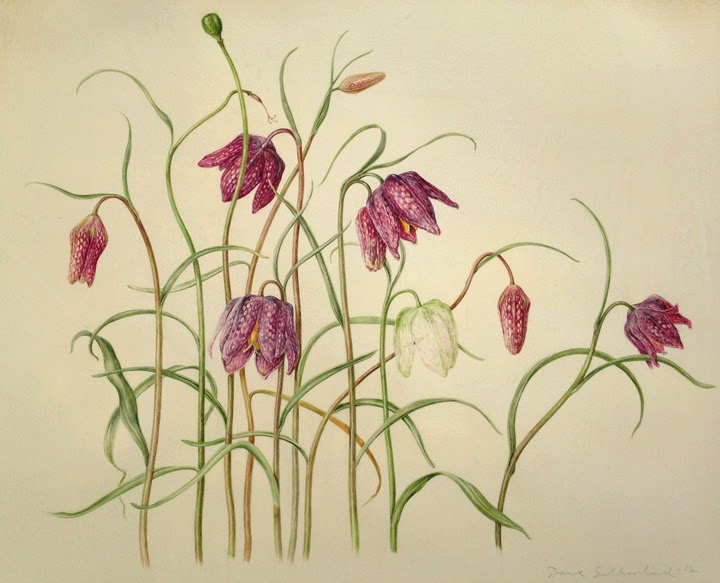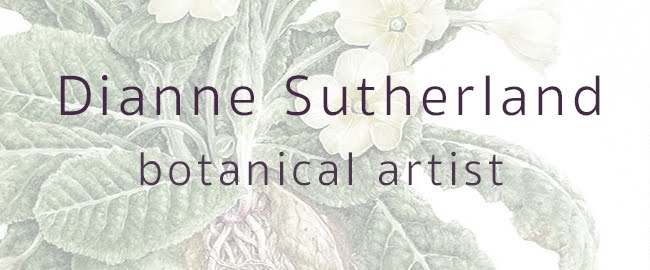Having woken up on New Year's day with the cold from hell, I was feeling more than a bit sorry for myself. But there's always an upside to everything and being confined to the armchair provided a good opportunity to reflect and plan for the year ahead, and, to do a bit of sketching.
 |
| Let the sketching begin! Crow skull, graphite on Stillman & Birn Zeta sketchbook paper, life size. |
Initially I thought I hadn't achieved all that much with work over the last year but making a rough plan at the beginning of the year and reviewing it at the end is very useful. I won't be beating myself up too much about the 'incomplete things' - it was a hectic year! Life events tend to drain energy, time and money but things settled mid November 2014 when I finally started to put down some roots again. Now that I have somewhere to work and the Festivities are dealt with the time has come to get stuck into some serious work but I feel the need to warm up first with some sketching. In fact sketching has been elevated to the number one activity in my New Year resolutions!
 |
| Roe deer skull, Graphite. Life size study A4 Stillman & Birn Zeta Sketchbook. Completed using the hatching. |
The sketches don't necessarily have to be botanical and it's sometimes better if they're not - other subject seem to help me to loosen up the drawing style. I made a start on some old skulls,
they're very good subjects, as are seed pods and shells, dead insects etc. .... you see they don't
move or wilt! The aim is to work fairly quickly on these sketches, always from life .....and done on a regular basis. Sketching and
tonal drawing is all important, and a botanical painting is pointless if the
drawing is off and the tones aren't there. My daughter, Polly, is home from University too so she's been joining in
and yes she's got a blog too!
Looking Back
Having had a good think about last year and looked at the positive things as well as the things I could have done differently it's not been so bad! I'd forgotten half of the things so trawling through the blog made me realise that more has been achieved than I originally thought.
Painting and drawing is my job. I teach people, sell original work and illustrate all sorts of weird and wonderful natural things, from rice packaging to the internal structure of a bony fish! It's a notoriously unstable and slightly chaotic work choice, particularly if you're a solo act. Sometimes it's hard to make the best decisions because I'm torn between what I want to do and what I have to do but wouldn't change it for anything else in the world. This career choice means that I have to work hard, plan well and be organised. It's not just about painting either, there's some serious multi-tasking including, promotion, websites, book keeping etc. etc.
 |
| RHS Show Orchid Show in April at the Lindley Hall. Great fun but unprepared! Photograph courtesy of Alena Lang Phillips |
Last year I wasn't terribly organised when I committed to the April RHS show, I had applied for the October, Shades of Autumn show - but for some unknown reason I ticked the box selecting the London Orchid Show as second choice.... That was my first mistake! Never put a second choice if you haven't got time! I've done 5 RHS shows since 2004 and always applied for London as first choice but never been allocated it, so felt I had to do it when it finally came my way.
 |
| Behind the scenes the frantic preparation! before the plants die |
Other work commitments meant I was left with just a few weeks to paint 6 works on vellum...it wasn't the best idea but it was 'do-able' if I kept it small and simple. That was a criticism by judges, they wanted more like this one, and less of the simple studies. It went a bit wrong at times and I didn't have time to present them properly either, but I got them all finished and made it to London. I have since done a bit more work on some of them and mounted and framed the the unsold ones.
 |
| Fritillaria meleargris, exhibited at the London Orchid show |
It was a great experience and I enjoyed it enormously, met lots of lovely people, many of who I've only ever communicated with via email. I was awarded a Silver and sold two of the paintings but I know that more time is needed to prepare for such high profile show and so I learned from it. Long term planning is the key and it's something I need to refocus on after the upheaval of the last 2 years. If I ever apply again I'll prepare the paintings and then apply for space when and only if I'm happy with them.
 |
| From the Royal Brompton and Harefield Exhibition flier |
I also managed to exhibit 16 paintings at the Royal Brompton and Harefield Hospital Trust with my good friend Julie Whelan. A fantastic opportunity, thanks to Julie. Arts in hospitals is a great initiative, it brings a diverse selection of work into the hospital environment for the benefit of both patients, visitors and staff, and, with commission going to a good cause! We dropped off the paintings at the hospital and were given a tour of the old world famous Harefield, they have some super work in their collection including a beautiful urn by Grayson Perry. The paintings went on to be exhibited at the Royal Brompton until November.
I'm spending time researching the exhibitions calendar for the next few years. I hope to submit work for this years
SBA Annual Show, In Pursuit of Plants.
It's 3 years since I last did the SBA show and I aim to submit just one large piece on vellum.
Back in May I wrote about the
Jade Vine painting. I'm almost ready to send off the digital image this month for the
Sydney Florilegium Exhibition, which takes place next year at Royal Botanic Garden, Sydney. I've worked on this over a two year period after tracking down the plant at Kew and Durham Botanic Garden.
 |
| I visited Kew to observe the amazing jade vine earlier this year. |
 |
| Work in progress. The finished painting will be scanned and sent as a digital image at the end of Jan, that's for the for printing. The original will be packed off to Australia shortly afterwards. |
Teaching and Websites
Over the last few years I've written a number of
online courses, it's great fun and I have some lovely students. It's a constant learning curve for me as well as for the students and it's important to learn from their feedback. The materials are delivered via a dedicated course website, which I constructed and manage and we have a private Facebook group too. This year I'm undertaking some new materials
on Composition as well as adding to existing courses and developing things a stage further.....gotta keep up with the technology!
 |
| A video still from the Botanical Watercolour Course | | |
|
My method of teaching, I hope, looks at the fundamental techniques and theory behind drawing and painting for the botanical student. It's not an 'easy option'
approach and requires hard work but I believe it's an approach that will
give students the building blocks that they need to develop their own
style and to work independently as artists in their own right beyond the course.
 |
| A still from the Course website |
Blogging Birthday Ahead!
On Jan 18th I will have been writing this blog for 6
years! There have been some gaps over this period, initially it felt like a bit of a waste of time - there seemed no way of finding others with the same interest but the amazing
Sigrid Frensen found me and was thinking along the same lines. Sigrid had started a Botanical Art Facebook group, which I later joined as co-admin. It now has over 2000 members! So the whole Botanical digital world has grown enormously in the last few years and it's much easier to find people, and, there are now lots of amazing botanical art blogs to read. Writing the blog is something that I really enjoy, hopefully others find it useful too and it's a brilliant way of keeping a diary for me..... I'll need to think about some way of celebrating!
Continue with the Sketchbook Project
See my
previous blog post. This time next year the project will be coming to an end and I'm very very excited to get my book back!
Finally... see more of the World and Exhibitions
One of the things I've pursued this year is travel, something that I hadn't really done a lot of up until a couple of years ago. I've seen lots of exhibitions, including most recently the Picasso Expo in Brugge, also the Dali exhibition. I've visited many galleries at home, looking at a wide variety of styles, from the fantastic Shirley Sherwood Collection and Marianne North at Kew, to Andy Warhol at Tate Liverpool and Turner Prize winner Martin Creed at the Hayward. It's something that has been invaluable.....diversity is definitely good for the mind! Travel has also given me the opportunity to draw and sketch plants away from home and in the field. Here's one from earlier in the year from a trip to Switzerland, Austria and Germany.
 |
| Linaria vulgaris, sketches |
I'm travelling to Donegal in a couple of weeks so will see what I can find there to paint....there's always something to paint no matter where you are, whether its from the back garden or further afield.
That's about it for 2014 and the rough plan for 2015!













































